The other day I was talking about 308 scopes and then I received an e-mail asking me about what is the difference between rifle scopes and rifle sights?
Though the question wasn’t specific as there are many scopes and sights yet I’ll try explaining this. I know this is a bit confusing for most people. Difference between iron sights and red dot sights or what are reflex sights? And then what is a holographic sight?
No, worries, I will be explaining everything in simple English.
There’s so much lie being spread out on the web, some say that a red dot sight is one that places a dot on the target. This is untrue. Let’s start with some basics.
- ROMEO5 GUN SIGHT - The ROMEO5 1X20mm Red Dot Sight mounts on any platform, and even though it's...
- 2 MOA RED-DOT - For those avid shooters who admire classic red dot reticles on their gun sights, the...
- MOTAC TECH - The versatile ROMEO5 red dot sight features our Motion Activated Illumination...
- Tubeless design with 33mm reflex lens aperture provides a wide field of view.
- Dual illuminated ( red and green);4 reticle shapes in one reflex sight, provide various choices in...
- Parallax corrected & unlimited eye-relief, improving the accuracy of holographic sights. Allen head...
Last update on 2024-04-14
What is the Difference Between a Rifle Sight and a Rifle Scope?
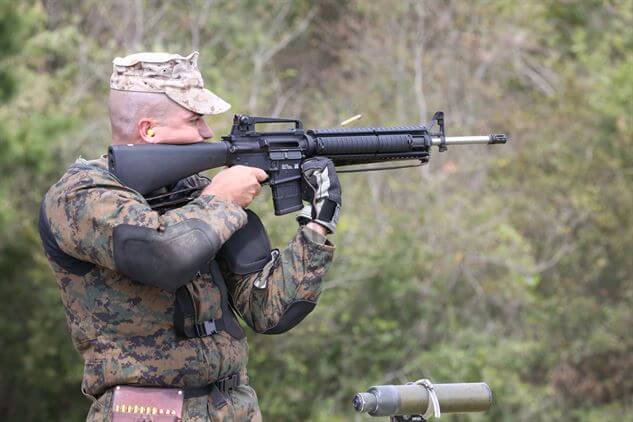
A sight is generally which uses little to no magnification. Understand sight as what you generally see through your eyes (means there’s no magnification).
A scope or a telescopic sight is the one that uses magnification to see the target better. They are tubular shaped. I have already discussed a lot about scopes here.
Furthermore, sights are of various types:
- Electronic Sights.
- Iron Sights/Open Sights.
Electronic Sights can be further divided into:
- Reflex Sights
- Prismatic Sights
- Holographic Sights
- Laser Sights
For the sake of this article, I have used the term “electronic” for all the sights using electrical system or LASER.
Iron Sights:
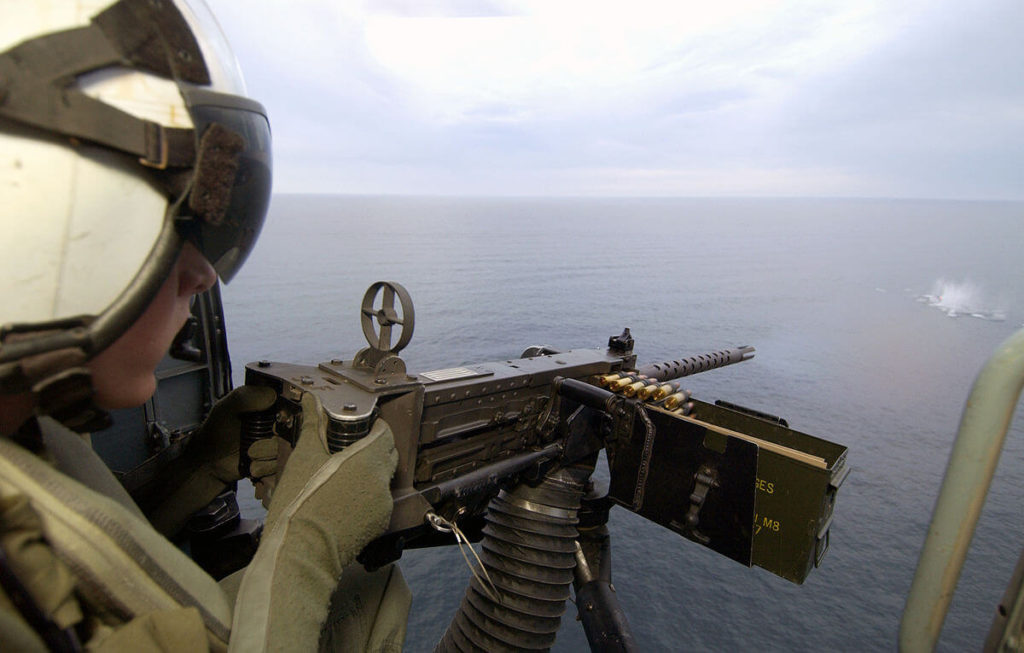
I will not talk about Iron sights here as I think that most of you know about them. Iron sights are further divided into:
- Open Sights.
- Aperture Sights.
- Shotgun Sights.
Also Read: The 5 Best Flip-Up Sights That Will Keep You In The Fight
Reflex Sights:
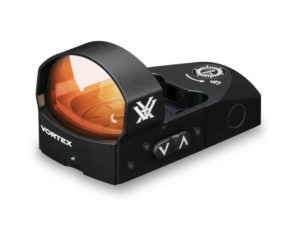
Vortex Venom Red Dot Sight
As the name tells, in reflex sights the reticle is formed behind the objective lens and is then reflected to the eye.
The Red Dot Sights come under this category. You might have noticed, the image you’re looking through it is a bit dark, well the reason is objective lens as it doesn’t allow sufficient light to pass through it.
Though it’s not a problem and quality sights give a good quality image because the coating on the lenses are such that they reflect the LED illumination (generally red dot reticles).
The reticle can be dots, chevrons or triangles and are illuminated using LEDs. In reflex sights like from Trijicon and Meprolight, they use Tritium that can illuminate the reticle for well over a decade!
There are generally 2 types of Reflex Sights:
- Compact Sight: The compact type reflex sight (also known as head-up) have one lens and the reticle is formed closer to the shooter’s eye. [Example: Trijicon Reflex.]
- Tubular Sight: The tubular types look like a scope and have lens on the either sides (objective + eyepiece). [Example: Aimpoint Trijicon Tripower, Leupold, Tasco and Bushnell].
Advantages of Reflex Sights/Red Dot Sights:
- Quick target acquisition.
- No eye relief constraints.
Prismatic Sights:
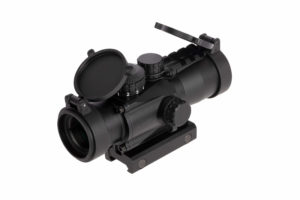
Primary Arms Gen II 3X
Prismatic sights or prism scopes are just like general scopes apart from the fact that they have lesser lenses.
In a normal rifle scope, you have an objective lens through which the light passes and gets focused on a point. When the shooter looks through the eyepiece (ocular lens), the point is magnified.
A prism scope works on the same concept but instead of an objective lens, it uses a prism to focus the light to a point.
Lesser lenses make a prism scope compact in size.
Prism scopes are available in various fixed magnification, starting from 1x and generally up to 6x. They are generally used for short to medium range shooting.
Prism scopes have the reticle etched to the glass. The reticle can be illuminated too. When the battery dies out, you can still use it.
Generally, you can get BDC reticles for specific calibres like .308 Winchester. Also, prismatic sights have eye relief unlike reflex sights.
Advantages of a Prism Scope:
- Prismatic scopes come with mounts.
- Has options of BDC turret.
- Diopter settings for people with astigmatism.
- Generally, can be used up to 500 metres.
Holographic Sights:
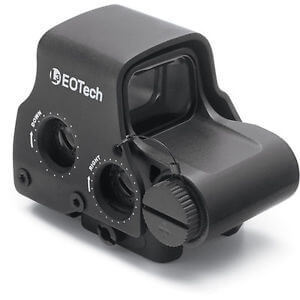
Eotech Holographic Sight
Holographic Sights are also known as Holographic Weapon Sights. Unlike the red dot where you see only the dot on the lens, in holographic sights the reticle gets placed around the target.
This is generally done using a laser. The photograph of the reticle is placed between glass layers and through it the shooter views the target.
Also Read: The Best Holographic Sights: Worth to Jump Down the Money Pit!
The reticle can be of any shape and in theory even in 3D shape.
Typically, holographic sights are head-up type. They can’t be mounted low because of this.
They are a great choice for close and medium scenarios and can be used for moving targets.
All in all, Reflex and Holographic Sights are different concepts for same type of scenarios.
Laser Sights:
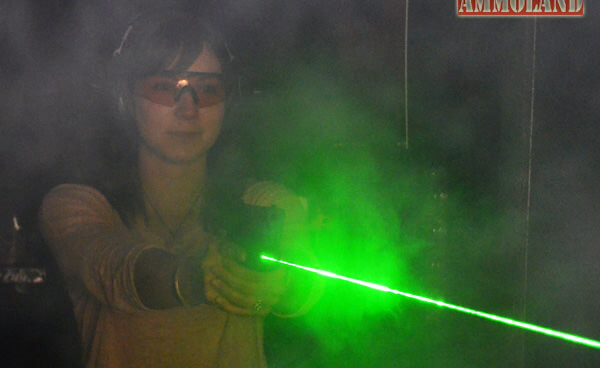
Laser Sights are not Holographic Sights. As explained above, Holographic sight uses laser to form a hologram on the target whereas these have elevation and adjustments (for zeroing the laser with rifle) and are used as a pointer to tolerate the recoil of the rifle.
Compared to the Reflex and Hologram Sights, these require lots of power. Also, weather conditions like fog, rain and dust are factors that affect the distance traveled by the laser and its visibility.
Think about crosshairs in your scope being invisible till you get on your target. Similarly, you can’t see the laser unless it falls on an opaque object.
What’s the Difference between Prism Scope and Red Dot Sight?
Prism Sights and Red Dot Sights are 2 different concepts for a similar purpose.
Advantages of Red Dot Sights and Prism Scopes:
Advantages of Red Dot Sights
- Quick target acquisition.
- You can still target better without focusing too much.
- You can target with both eyes open.
- Red Dots are compact.
- They come with 1x magnification.
- Can be used for close range target.
- Red dot sight doesn’t have a reticle.
- Limited to 100 meters.
- You get an unlimited eye box relief.
- Red Dot Sights are compact in size.
Advantages of a Prism Scope
- Prism Scopes are better than Red Dot Sights if you have astigmatism.
- They start with 1x magnification and go generally up to 6x.
- They can be used for short to medium range targets.
- They have an etched reticle.
- Prism Scope goes anywhere to 500 metres
- Prism Scopes come with integrated mounts.
What is the Difference Between Holographic Sights and Red Dot Sights?

Though the differences aren’t much diverse, but the concept of working is different.
As explained above, Red Dots work with LED and Holographic Sights work with LASER, hence Red Dot Sights have longer battery life due to lower power consumption.
The Holographic Sight places a reticle around the target whereas in a Red Dot Sight, the dot covers the target.
In a red dot sight, the red dot looks as if it rests on the target while in the case of holographic sight, the reticle seems to float over the target.
While zooming in the target the dot in a Red Dot Sight increases in size whereas the reticle in a Holographic Sight remains of the same size.
Talking about parallax, Holographic Sights easily outshine Red Dots. Thanks to the Holographic reticle that helps in reducing the error.
Now talking about the disadvantages, Holographic Sights aren’t immune to diverse temperature differences unlike Red Dot Sights. This means you can’t take a Holographic Sight to a very cold or very hot place.
Holographic Sights are complex and bulky as compared to Red Dots.
Conclusion:
- There’s a difference between a sight and a scope.
- Red dots are a part of Reflex sights.
- A prism sight works on the same concept of rifle scope but uses a prism to focus the light.
- A red dot works with LED hence consumes less power than a holographic sight which uses a LASER instead.
I hope this post would have helped you.
If you’ve any questions or suggestions, please comment below or contact me via the contact form.
Over and out.
Related Posts:
Image Credits:
midwayusa.com
primaryarms.com
ammoland.com


